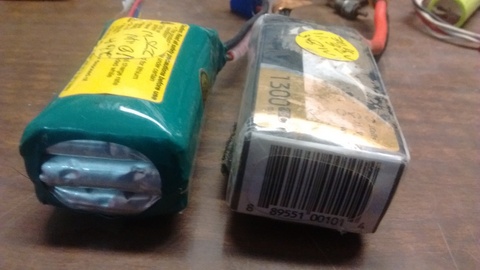
Here are some pitfalls and safety issues to watch out for while handling and charging Li-Po batteries. This goes for Electrics, RX packs, and TX packs.
1. Only a Li-Po charger can charge Li-Po batteries. These chargers are current limited until max. voltage of 4.2V/cell (80% charge) then voltage limited until a fraction or the original current is reached (last 20%).
2. Most transmitters can use or be fitted for Lithium batteries but don’t try to use the simple wall block chargers that are usually made for charging Ni-CD or Ni-HM. You will start a fire.
3. Be sure to “balance charge” over other selected methods. This requires both plugs from the battery to be used. The power end is usually for charging and the balance port is connected to monitor and/or load the highest cell to minimize overcharging. Overcharging occurs when a single cell or more goes over the max voltage. For Li-Po this is 4.2V/cell. If the final voltage to stop is 12.60V as for a 3S without balance that 12.6 COULD come from 4V+4.3V+4.3V. You still have 12.6V but 2 cells are overcharged!!
4. Make sure you have the correct type of battery selected. Li-po is a different makeup than Li-Ion or Li-FE or Li-HV.
5. Don’t ASSUME the confirmation screen that comes up after you press START is correct without paying attention. A 4S in a discharged state (3Vx4cells=12V) can be the same voltage as a 3S in a fully charged state 4.2Vx3cells=12.6) . Charging a 3S on a 4S setting WILL START A FIRE.
6. Don’t leave a charging Li-Po battery unattended. If a 3S starts on fire each of the cells burns individually. At least put it in anything that is fire resistant. A metal box or pot, a cinder-block,…
7. Never leave a fully charged battery in a hot car. The heat will raise the cell voltage and an overcharged battery is very unstable.
8. Never poke the aluminum pouch. When lithium hits air it combusts. Even putting a battery in your pocket with keys can cause a short or poke the pouch.
9. Take extra, extra care in changing connectors or cutting leads. Shorting a main lead (red/blk) or even cutting the balance connector wires short a cell and cause immediate max current. You can weld with the power any li-po. I have had pliers slip and a soldering iron slip when holding a connector I was soldering. NOT GOOD!!
10. Your packs will last longer if you leave them at a storage voltage (3.6-3.7 volts per cell) for periods of a week or more of non use. I never recommend charging over a 1C rating. 4000MAH capacity pack 1C = 4A. 1300MAH pack, 1C = 1.3A and a 500MAH pack 1C = .5A
11. Puffed batteries are a sign of overcharging or drawing too much current. If/ when the puff causes the pouch to leak then FIRE. I have never found a C rating that can be maxed for more than a few seconds without damaging the pack. I recommend a safety margin or 50% of C for safety. EX: 2200mah at 50c rating should supply 50X2.2A or 110A. If you keep this pack below 55A you might not have a problem. #2. A 1000mah pack rated 10C should supply 10A (1X10) if the design is kept at 5A the pack should never puff.
Finally always remember to disconnect you battery pack from your ESC when your done flying. Even leaving a mini tester or a balancer connected for hours or overnight will ruin a li-po by slowly discharging it to less than 3V if not ZERO.
If you have any questions or other ideas please let me know.
Bruno

Great article Bruno Thanks.
Question for you. We had a new lipo battery get discharged where the charger would not charge it.. I had herd you could sometimes bring one of these batteries back to life by charging with a NMH setting bringing the batteries slowly till the you have the battery so you can charge it using the LIPO settings. Is this dangerous. We were Successful.
Hi Rick, It’s not safe to charge as NIMH or NICD from the battery’s power connector port as you can’t see what’s happening to each individual cell in a multi-pack. If you charge from the balance port you can watch what’s happening to that individual cell and be sure that there is no heating up and then stop as soon as the voltage of that cell gets to almost 3.7 V. Then switch to regular Li-Po balance charging. Just be careful that probing the balance port is easy to cause a short. Those small wires can burn up in a few seconds or less. I use a special balance connector plug to hook to the charger.